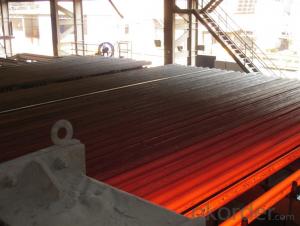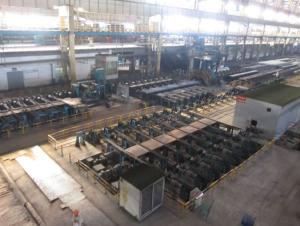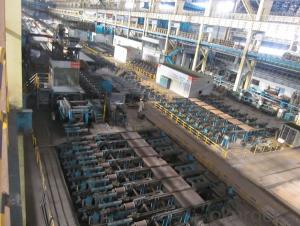Prime quality square alloy steel billet 80mm Q235
- Loading Port:
- Tianjin
- Payment Terms:
- TT OR LC
- Min Order Qty:
- 100 m.t.
- Supply Capability:
- 10000 m.t./month
OKorder Service Pledge
OKorder Financial Service
You Might Also Like
Structure of Prime quality square alloy steel billet 80mm Q235

Description of Prime quality square alloy steel billet 80mm Q235
1. Prepainted steel coil is coated with organic layer, which provides higher anti-corrosion property and a longer lifespan than that of galvanized or galvalume steel sheets.
2. The base metals for prepainted steel coil consist of cold rolled, HDGI Steel, electro-galvanized and hot-dip alu-zinc coated steel. The finish coats of prepainted steel coil can be classified into groups as follows: polyester, silicon modified polyesters, polyvinylidene fluoride, high-durability polyester, etc.
3. The production process has evolved from one-coating-and-one-baking to double-coating-and-double-baking, and even three-coating-and-three-baking.
4. The color of the prepainted steel coil has a very wide selection, like orange, cream-colored, dark sky blue, sea blue, bright red, brick red, ivory white, porcelain blue, etc.
5. The prepainted steel coils can also be classified into groups by their surface textures, namely regular prepainted sheets, embossed sheets and printed sheets.

Main Feature of Prime quality square alloy steel billet 80mm Q235
Uncoated CR steel sheet
With the features of in line with the international highest standards in demension and shape, excellent surface finish and properties, the products are mainly used in home appliance and automobile industries.
Galvanized steel sheet(include HDG and EG)
With the features of good corrosion resistance, the products are mainly used in automobile, home appliance, electronics, building and machinery manufacture industries, etc.
Precoated steel sheet
With the features of enviromental protection and good processablility, long lasting surface durability, rich in colors, the products are maily used in building, home appliance and furniture industries, etc.
Applications of Prime quality square alloy steel billet 80mm Q235
Construction
Manufacture anticorrosion, industrial and civil architecture roof boarding, roof grille
Light industries
Home appliance's case, civil chimney, kitchen utensils
Auto industry
Corrosion resistant parts of cars
Agriculture
Food storage, meat and aquatic products' freezing and processing equipment
Commerce
Equipments to store and transport materials, and packing implements

Specifications of Prime quality square alloy steel billet 80mm Q235
Product | Prime quality square alloy steel billet 80mm Q235 |
Material Grade | SGCC / SGCH / DX51D+AZ, etc |
Thickness | 0.6-3.0mm |
Width | 500-1500mm |
Tolerance | Thickness: +/-0.02mm , Width:+/-2mm |
Zinc-coating | Z30-150g/m2 |
Technique | Raw material: Hot rolled steel coil --> Cold rolled_>hot dipped galvalume |
Surface | Dried, Chromated, Unoiled |
Spangle | Regular spangle , small spangle, zero spangle |
ID | 508MM 610MM |
Coil weight | 1-25MT |
Export package | Cardboard inner sleeves, Waterproof paper, galvanized steel covered and steel strip packed |
FAQ of Prime quality square alloy steel billet 80mm Q235
We have organized several common questions for our clients,may help you sincerely:
1. How Can I Visit There?
Our company is located in Tianjin City, China, near Beijing. You can fly to Tianjin Airport Directly. All our clients, from home or aboard, are warmly welcome to visit us!
2. How Can I Get Some Sample?
We are honored to offer you sample.
3. Why choose CNBM?
Our delivery time about 15-20days for standard sizes, if you have other requirements like hardness, quanity and width ,it is about 20-40days. But don't worry we also try our best for the delivery time ,because time longer and our cost is higher.
- Q:How are steel billets inspected before they are used in production?
- Before being used in production, steel billets undergo a thorough inspection to ensure their quality and adherence to required specifications. The inspection process involves several key steps. Firstly, a visual inspection is conducted to examine the billets' surface for any defects such as cracks, seams, or deformities. Any irregularities can indicate potential weaknesses or problems that may affect performance during production. Secondly, dimensional inspection is performed to verify the billets' size, length, width, and other critical dimensions. This is crucial to ensure that the billets meet the precise requirements of the production process and can be seamlessly integrated into manufacturing operations. Thirdly, ultrasonic testing is often used to detect any internal defects or discontinuities within the billets. Ultrasonic waves are passed through the billet, and reflections or echoes are analyzed to identify any flaws such as voids, inclusions, or cracks that may compromise the billets' structural integrity. Moreover, magnetic particle inspection may be carried out to identify surface or near-surface defects that are not visible to the naked eye. This technique involves applying magnetic particles to the billet's surface and detecting any magnetic leakage caused by defects through the use of magnetic fields. Additionally, chemical analysis is frequently performed to ensure that the steel billets have the desired chemical composition. This involves taking samples from the billets and subjecting them to various tests to determine the percentages of different elements present. This analysis guarantees that the billets possess the necessary chemical properties for the intended application. In conclusion, steel billets undergo a comprehensive inspection process that includes visual examination, dimensional verification, ultrasonic testing, magnetic particle inspection, and chemical analysis. This multi-faceted approach ensures that the billets meet the required quality standards and are suitable for use in production, minimizing the risk of any performance issues or failures during manufacturing processes.
- Q:What are the main properties of steel billets?
- Steel billets serve as the initial material for various steel products and possess several important properties that make them suitable for further shaping and processing. To begin with, steel billets demonstrate a high level of strength and durability. This is primarily attributed to the composition of steel, which consists mainly of iron with small amounts of carbon and other elements. This composition provides steel billets with exceptional mechanical properties, including high tensile strength and resistance to deformation. Moreover, steel billets exhibit favorable heat transfer properties. Steel is renowned for its efficient heat conductivity, making it an ideal material for applications requiring thermal conductivity, such as the production of automotive parts or construction materials. Furthermore, steel billets possess excellent machinability. Machinability refers to the ease with which a material can be shaped or formed using various machining processes. Steel billets can be easily cut, drilled, and shaped into desired forms, enabling efficient processing and fabrication. Additionally, steel billets display superb weldability. Steel is known for its compatibility with welding processes, enabling the joining of different steel components or the repair of damaged steel structures. This property is crucial in numerous industries, including construction, automotive, and shipbuilding. Lastly, steel billets have a high level of recyclability. Steel is one of the most widely recycled materials globally, with a significant portion of steel production derived from recycled steel. This environmentally friendly aspect makes steel billets an excellent choice as they can be recycled and repurposed multiple times without losing their properties. In conclusion, steel billets possess high strength and durability, favorable heat transfer properties, excellent machinability and weldability, and a high level of recyclability. These properties establish steel billets as a versatile and extensively used material in various industries, spanning from construction and manufacturing to automotive and aerospace.
- Q:What are the potential applications of steel billets in the mining industry?
- The mining industry can benefit greatly from the versatile uses of steel billets. Firstly, these billets can be shaped and welded to create various components for mining equipment and machinery. Frames, supports, and chassis for heavy machinery can all be constructed using steel billets due to their strength and durability. This allows them to withstand the harsh conditions and heavy loads encountered in mining operations. Secondly, steel billets are ideal for fabricating conveyor belts, which are essential for transporting bulk materials in mines. The high tensile strength of steel ensures that the conveyor belts can handle the weight of the materials being transported, as well as the constant movement and impact involved in the mining process. Furthermore, steel billets can be utilized in constructing underground support systems, such as mine shafts and tunnels. These structures require reliable and robust materials to ensure the safety of workers and the integrity of the mining operation. Steel billets can be used to manufacture support beams, rods, and plates, providing the necessary stability and reinforcement. In addition, steel billets are valuable in producing wear-resistant components crucial in mineral processing, such as grinding balls and liners. These components are used in grinding mills to crush and grind ore, and steel's abrasion-resistant properties make it an ideal material for this purpose. By incorporating steel billets, mining companies can enhance the efficiency and longevity of their mineral processing operations. Overall, steel billets have a wide range of potential applications in the mining industry. From manufacturing equipment and fabricating conveyor belts to constructing underground support systems and producing wear-resistant components, steel billets contribute significantly to improving the productivity, safety, and efficiency of mining operations.
- Q:How are steel billets used in the production of aerospace components?
- Steel billets are used in the production of aerospace components as they serve as the raw material for various manufacturing processes. These billets are typically forged or machined to create the desired shape and size of the aerospace component. Additionally, their high strength and durability make them suitable for withstanding the extreme conditions and rigorous demands of aerospace applications.
- Q:What is the maximum length of a steel billet?
- The maximum length of a steel billet can vary depending on various factors such as the manufacturing process, equipment capabilities, and specific industry requirements. In general, steel billets can range in length from a few inches to several meters. However, it is important to note that longer billets are often more challenging to produce and handle due to their increased weight and potential for deformation. Therefore, the maximum length of a steel billet is typically determined by practical considerations and operational limitations within the steel industry.
- Q:What is the billet price in China today?
- Building materials tend to be stable, the price is good to pick up the trend, the overall no big changes, specific to my steel network detailed inquiries, information here will be updated every day
- Q:How are steel billets heated for rolling?
- Steel billets are heated for rolling using a process called induction heating, where an electric current is passed through the billets to generate heat. This method allows for precise and efficient heating, ensuring uniform temperature distribution throughout the billets.
- Q:What are the main challenges in the supply chain management of steel billets?
- There are several main challenges in the supply chain management of steel billets. 1. Demand fluctuations: The steel industry is highly sensitive to economic cycles and changes in global demand. Fluctuations in demand can lead to imbalances in the supply chain, causing excess inventory or shortages of steel billets. This uncertainty makes it challenging for supply chain managers to accurately forecast demand and optimize production and inventory levels. 2. Transportation and logistics: Steel billets are heavy and bulky, making transportation and logistics a major challenge. Efficient transportation networks need to be established to ensure timely delivery of steel billets to customers. Moreover, the handling and storage of steel billets require specialized equipment and facilities, which can add complexity and cost to the supply chain. 3. Supply chain visibility: Lack of visibility and transparency across the supply chain can lead to inefficiencies and delays. It is crucial for supply chain managers to have real-time information on inventory levels, production status, and transportation schedules. This enables them to make informed decisions and mitigate any potential disruptions in the supply chain. 4. Quality control: Maintaining consistent quality of steel billets throughout the supply chain is vital. Steel billets are often produced by different manufacturers, and variations in quality can occur. Supply chain managers need to implement robust quality control processes to ensure that only high-quality billets are delivered to customers. This may involve regular inspections, testing, and strict adherence to industry standards. 5. Sustainability and environmental concerns: The steel industry is under increasing pressure to reduce its carbon footprint and adopt sustainable practices. Supply chain managers face the challenge of implementing environmentally friendly processes and sourcing steel billets from suppliers that adhere to sustainable practices. This may involve evaluating the environmental impact of transportation methods, optimizing energy consumption during production, and ensuring responsible sourcing of raw materials. In summary, the main challenges in the supply chain management of steel billets include demand fluctuations, transportation and logistics, supply chain visibility, quality control, and sustainability concerns. Overcoming these challenges requires effective planning, collaboration with suppliers and customers, and the use of advanced technologies to improve visibility and optimize processes.
- Q:What are the main factors affecting the strength of steel billets?
- The strength of steel billets can be influenced by several key factors. Firstly, the composition of the steel plays a vital role in determining its strength. The types and quantities of different elements present in the steel, such as carbon, manganese, and silicon, can enhance its strength by forming solid solutions or creating carbides. These modifications increase the steel's hardness and resistance to deformation. Secondly, the strength of steel can be affected by the heat treatment process. By subjecting the steel billets to controlled heating and cooling conditions, the microstructure of the steel can be altered, resulting in variations in its strength properties. Annealing, quenching, and tempering are different heat treatment methods that can be utilized to achieve specific strength characteristics. Additionally, the size and distribution of grains within the steel structure can impact its strength. Smaller grain sizes tend to increase the strength of steel by impeding dislocation movement and promoting grain boundary strengthening. Techniques like hot rolling and controlled cooling can be employed to produce fine-grained steel billets. Moreover, the microstructure of the steel, including the arrangement and morphology of different phases, can influence its strength. The presence of specific phases like martensite or bainite can significantly enhance the strength of steel by providing a more rigid and stable structure. The processing conditions during the production of steel billets also play a crucial role in determining their strength. Factors such as rolling temperature, deformation rate, and cooling rate can affect the microstructural evolution and mechanical properties of the steel. Controlling these processing parameters is essential to achieve the desired strength characteristics. Furthermore, the presence of inclusions or defects within the steel can weaken its strength. Non-metallic particles or voids act as stress concentrators and can initiate cracks or fractures, thereby reducing the overall strength and integrity of the steel billets. By considering and optimizing these factors, manufacturers can produce steel billets with improved strength properties. This enables their utilization in various applications that require high strength and durability.
- Q:How do steel billets contribute to the overall safety of a structure?
- Steel billets contribute to the overall safety of a structure by providing a strong and durable material for construction. The high strength and toughness of steel billets make them resistant to external forces such as earthquakes, wind, and heavy loads. Additionally, steel billets have excellent fire resistance, as they do not burn or release toxic gases when exposed to high temperatures. This ensures the structural integrity of the building during a fire. Moreover, steel billets can be easily fabricated into various shapes and sizes, allowing for precise engineering and construction, which further enhances the safety and stability of the structure.
1. Manufacturer Overview |
|
|---|---|
| Location | |
| Year Established | |
| Annual Output Value | |
| Main Markets | |
| Company Certifications | |
2. Manufacturer Certificates |
|
|---|---|
| a) Certification Name | |
| Range | |
| Reference | |
| Validity Period | |
3. Manufacturer Capability |
|
|---|---|
| a)Trade Capacity | |
| Nearest Port | |
| Export Percentage | |
| No.of Employees in Trade Department | |
| Language Spoken: | |
| b)Factory Information | |
| Factory Size: | |
| No. of Production Lines | |
| Contract Manufacturing | |
| Product Price Range | |
Send your message to us
Prime quality square alloy steel billet 80mm Q235
- Loading Port:
- Tianjin
- Payment Terms:
- TT OR LC
- Min Order Qty:
- 100 m.t.
- Supply Capability:
- 10000 m.t./month
OKorder Service Pledge
OKorder Financial Service
Similar products
New products
Hot products
Related keywords

































